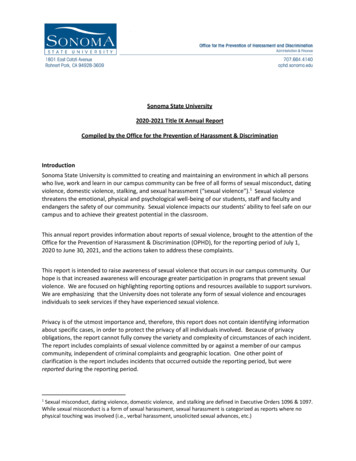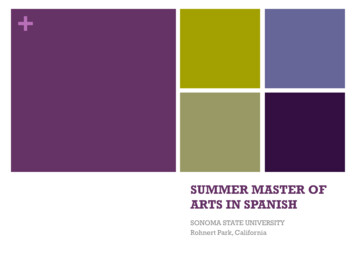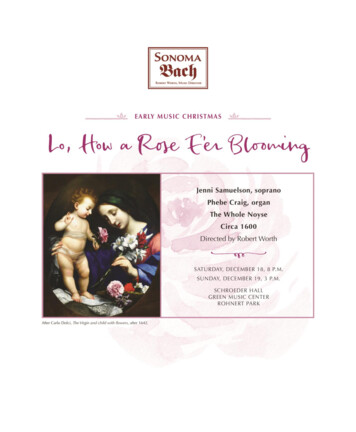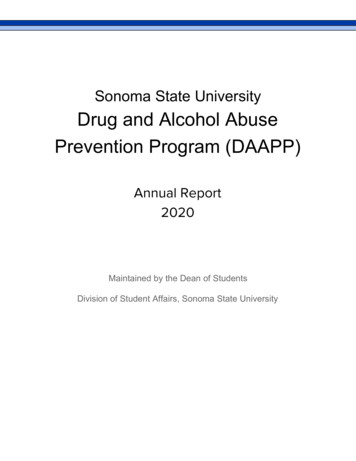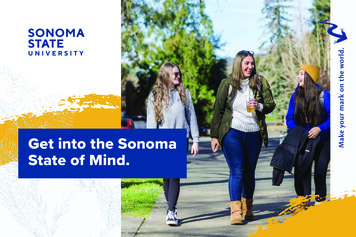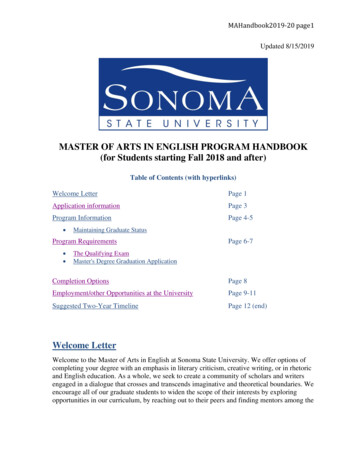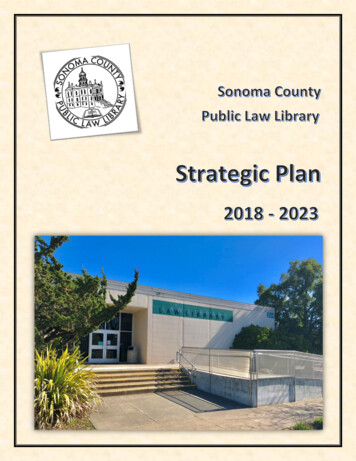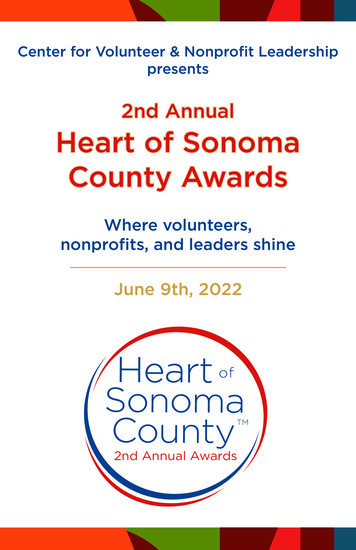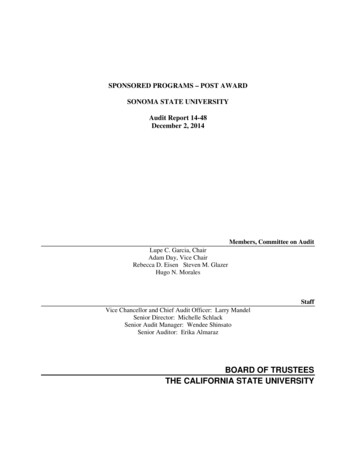
Transcription
SPONSORED PROGRAMS – POST AWARDSONOMA STATE UNIVERSITYAudit Report 14-48December 2, 2014Members, Committee on AuditLupe C. Garcia, ChairAdam Day, Vice ChairRebecca D. Eisen Steven M. GlazerHugo N. MoralesStaffVice Chancellor and Chief Audit Officer: Larry MandelSenior Director: Michelle SchlackSenior Audit Manager: Wendee ShinsatoSenior Auditor: Erika AlmarazBOARD OF TRUSTEESTHE CALIFORNIA STATE UNIVERSITY
CONTENTSExecutive Summary . 1Introduction . 2Background . 2Purpose . 4Scope and Methodology. 5APPENDICESAPPENDIX A:APPENDIX B:Personnel ContactedChancellor’s alifornia State UniversityExecutive OrderIntegrated California State University Administrative ManualNational Institutes of HealthNational Science FoundationOffice of Management and BudgetOffice of Audit and Advisory ServicesSponsored Programs – Post Awardii
EXECUTIVE SUMMARYAs a result of a systemwide risk assessment conducted by the Office of Audit and Advisory Services(OAAS) during the last quarter of 2012, the Board of Trustees (BOT), at its January 2013 meeting,directed that Sponsored Programs – Post Award (PA) be reviewed. Based on the results of the first cycleof these reviews and the systemwide risk assessment conducted by the OAAS in the last quarter of 2013,the BOT directed at its January 2014 meeting that the OAAS continue these reviews. The OAAS hadalso previously reviewed Post Award in the triennial audits of Auxiliary Organizations.We visited the Sonoma State University campus from September 22, 2014, through October 24, 2014,and audited the procedures in effect at that time.In our opinion, the fiscal, operational, and administrative controls for PA activities in effect as ofOctober 24, 2014, taken as a whole, were sufficient to meet the objectives stated in the “Purpose” section ofthis report. There were no major findings revealed during our review.As a result of changing conditions and the degree of compliance with procedures, the effectiveness ofcontrols changes over time. Specific limitations that may hinder the effectiveness of an otherwiseadequate system of controls include, but are not limited to, resource constraints, faulty judgments,unintentional errors, circumvention by collusion, and management overrides. Establishing controls thatwould prevent all these limitations would not be cost-effective; moreover, an audit may not always detectthese limitations.Sponsored Programs – Post Award/Sonoma State University/Incomplete Draft/Audit Report 14-48Page 1
INTRODUCTIONBACKGROUNDSponsored programs include all work performed under grants or contracts funded by non-California StateUniversity (CSU) sources, such as federal agencies, state agencies, and non-profit organizations. Thereare generally two main components of sponsored program administration: pre-award, which includesactivities such as proposal development, review, and submission prior to acceptance of funds; and postaward, which includes administration of a sponsored program after the grant or contract has been awardedthrough the final closeout process.Sponsored programs – post award (PA) may be administered either on the campus, usually under anoffice of research or similar department, or by an auxiliary organization, such as a research foundation.Five CSU campuses – Channel Islands, Maritime Academy, San Francisco, Sonoma, and Stanislaus – andthe chancellor’s office administer the post-award aspects of sponsored programs on the state side. Theother 18 CSU campuses manage PA through auxiliary organizations.PA is subject to various types of audits, including internal audits by the Office of Audit and AdvisoryServices (OAAS) and external audits required by granting agency regulations. For those campuses wherean auxiliary organization manages PA, the OAAS conducts triennial auxiliary organization audits, whichinclude audits of the PA function. In addition, the OAAS performs periodic campus audits of sponsoredprograms, the most recent of which was an audit of PA in 2013. The primary external audit performed isthe annual A-133 audit, which is required for non-federal entities that expend 500,000 or more in federalawards in a year, and which is performed by external financial statement auditors. In addition, periodicaudits may be performed by sponsors, including various federal inspector general offices.The Office of Management and Budget (OMB) has issued the following government-wide policies toensure proper stewardship of federal research funds: OMB Circular A-21, Cost Principles for Educational Institutions, establishes principles fordetermining costs applicable to grants, contracts, and other agreements with educational institutions.These principles are designed to ensure that the federal government bears its fair share of total costs,determined in accordance with generally accepted accounting principles, except where restricted orprohibited by law. The circular was last revised in May 2004. OMB Circular A-110, Uniform Administrative Requirements for Grants and Agreements withInstitutions of Higher Education, Hospitals, and Other Non-Profit Organizations, sets forth thestandards for obtaining consistency and uniformity among federal agencies in the administration ofgrants and agreements with institutions of higher education, hospitals, and other non-profitorganizations. The circular was last revised in November 1993 and amended in September 1999. OMB Circular A-133, Audits of States, Local Governments, and Non-Profit Organizations, sets forthconsistency and uniformity among federal agencies for the audit of states, local governments, andnon-profit organizations expending federal awards. The circular was last revised in June 2007. TheOMB Circular A-133 Compliance Supplement, which was last revised in June 2012, serves as acompanion document.Sponsored Programs – Post Award/Sonoma State University/Incomplete Draft/Audit Report 14-48Page 2
INTRODUCTIONOther federal guidance for sponsored programs has been disseminated by specific sponsoring agencies.Among the largest sponsors are the National Institutes of Health (NIH) and the National ScienceFoundation (NSF). The NIH Grants Policy Statement, last revised in October 2013, and the NSF Awardand Administration Guide, last revised in February 2014, delineate policy requirements for theadministration of projects funded by these agencies.Compliance requirements for sponsored programs change as new regulations or policies are implemented.For example, new NIH requirements relating to financial conflict-of-interest identification and reportingbecame effective on August 24, 2012. In addition, on December 26, 2013, the OMB published a unifiedOmni Circular, which consolidates the three circulars mentioned above and five others into one documentthat supersedes the separate circulars with the intent of streamlining federal requirements for all types ofrecipients of federal grants and contracts, and of increasing the efficiency and effectiveness of the federalaward process. Federal agencies have six months to provide their implementation plans to OMB, andcolleges and universities will have until December 26, 2014, to comply with the new rules.Executive Order (EO) 890, Administration of Grants and Contracts in Support of Sponsored Programs,dated January 7, 2004, sets policy to be followed by each campus and any auxiliary organizationadministering sponsored programs to ensure that the university or auxiliary maximizes the benefits ofsponsored programs and supports faculty, students, and administrators in effectively securing andcarrying out sponsored programs. EO 890 requires that each campus establish a written policy on themanagement of sponsored programs that incorporates components such as proposal submission, review,and approval; performance of grants and contracts; human resources policies; academic policies; fiscaladministration; and work product and records.Integrated California State University Administrative Manual (ICSUAM) §11000 sets forth systemwidepolicies related to specific aspects of sponsored programs. These policies were created in response to the2010 PA audit conducted by the OAAS. Policies relevant to the current audit include: ICSUAM §11000.002.005, Subrecipient Monitoring, effective December 1, 2011ICSUAM §11000.003.005, Allowable Costs, effective December 1, 2011ICSUAM §11000.003.006, Effort Reporting, effective December 1, 2011ICSUAM §11000.003.007, Cost Sharing, effective December 1, 2011ICSUAM §11000.010.002, Financial Conflict of Interest, dated October 31, 2011The CSU Conflict of Interest Code also requires principal investigators for projects sponsored bynongovernmental entities to disclose financial interests. Coded memorandum Human Resources 2005-38,Conflict of Interest Update – Principal Investigators, dated August 30, 2005, outlines reportingrequirements, as well as management of potential conflicts of interest.Sponsored Programs – Post Award/Sonoma State University/Incomplete Draft/Audit Report 14-48Page 3
INTRODUCTIONPURPOSEOur overall audit objective was to ascertain the effectiveness of existing policies and procedures related tosponsored programs – post-award administration and to determine the adequacy of controls that ensurecompliance with relevant governmental regulations, Trustee policy, Office of the Chancellor directives,and campus and auxiliary organization procedures.Within the overall audit objective, specific goals included determining whether: Administration of post award is well defined and includes clear lines of organizational authority andresponsibility. Policies and procedures exist for key areas of post-award administration, such as effort reporting, costsharing, sub-recipient monitoring, and fiscal administration, and are current, comprehensive, andeffectively distributed. Individuals involved in post-award administration are provided with sufficient initial and ongoingtraining. Financial interests in sponsored programs are disclosed in a timely manner and reviewed for conflictsof interest. An integrated system that encompasses both sponsored and all other activities, and that ensuresaccurate and properly documented evidence of work performed on sponsored programs, is in placefor effort reporting. Administration and management of cost sharing on sponsored programs is adequate and performed inaccordance with CSU, federal, and sponsor requirements. Sub-recipient relationships are appropriately established and monitored in accordance with CSU,federal, and sponsor requirements. Financial systems and controls are adequate to ensure that costs charged to sponsored programs areallowable, allocable, and reasonable. Financial systems are adequate to ensure that cost transfers are made with adequate justification, withproper approvals, and within a reasonable period of time. Indirect costs charged to sponsored programs are appropriate, and approved indirect cost rates areutilized.Sponsored Programs – Post Award/Sonoma State University/Incomplete Draft/Audit Report 14-48Page 4
INTRODUCTIONSCOPE AND METHODOLOGYThe proposed scope of the audit as presented in Audit Agenda Item 4 of theJanuary 28 and 29, 2014, meeting of the Committee on Audit stated that Sponsored Programs – PostAward (PA) includes a review of the post-award administration and management of sponsored programsfunded by non-CSU funding sources. Proposed audit scope could include, but was not limited to, reviewof contract and grant budgeting and financial planning; indirect cost administration, including costallocation; cost sharing/matching and transfer processes; effort reporting, fiscal reporting, and progressreporting; approval of project expenditures; sub-recipient monitoring; and management and security ofinformation systems.Our study and evaluation were conducted in accordance with the International Standards for theProfessional Practice of Internal Auditing issued by the Institute of Internal Auditors and included theaudit tests we considered necessary in determining whether fiscal, operational, and administrative controlsare in place and operative. This review emphasized, but was not limited to, compliance with federal andstate regulations and guidance, Board of Trustee policies, and Office of the Chancellor and campuspolicies, letters, and directives. The audit focused on procedures in effect from July 1, 2012, throughOctober 24, 2014.We focused primarily on the internal administrative, compliance, and operational controls over PAactivities. Specifically, we reviewed and tested: Administration of PA activities, including defined responsibilities, current policies and procedures,and training. Conflict-of-interest policies and required conflict-of-interest filings. Effort reporting systems. Cost-sharing administration and management. Sub-recipient monitoring processes. Fiscal administration, including cost transfers, indirect costs, and allowable costs.Sponsored Programs – Post Award/Sonoma State University/Incomplete Draft/Audit Report 14-48Page 5
APPENDIX A:PERSONNEL CONTACTEDNameTitleRuben ArmiñanaBarbara CrandellTania CraneDavid CrozierLaurence Furukawa-SchlerethNathan JohnsonKurt KoehleMary PraetzellisGiovanna RossettiMing-Lan (Joy) SunJeff WilsonPresidentSponsored Project AdministratorAccounting Analyst Lead, Financial ServicesSenior Director, University Financial ServicesVice President, Administration and FinancePolice Chief and Executive DirectorDirector, Internal OperationsAssociate Director, Anthropological Studies CenterBusiness Manager, Anthropological Studies CenterManager of Contracts and ProcurementSenior Director, Sponsored Programs Administration
Five CSU campuses - Channel Islands, Maritime Academy, San Francisco, Sonoma, and Stanislaus and - the chancellor's office administer the post-award aspects of sponsored programs on the state side. The other 18 CSU campuses manage PA through auxiliary organizations.
